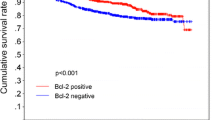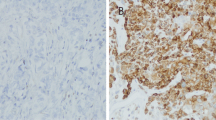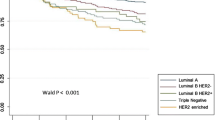Abstract
Purpose
Outcome for patients with Wilms tumor (WT) with favorable histology is good. Deletions of chromosomes 1p and 16q impart a poorer outcome. Value of apoptotic protein expression is not clear.
Methods
Expression of four immunohistochemically detectable apoptosis-regulating proteins (bcl-2, bcl-x, bax and p53) were analyzed in 30 specimens of WT and compared to recurrence and recurrence-free survival (RFS).
Results
The 30 patients included ranged from 4 to 72 months in age (mean 31). The mean available follow-up was 35.3 months (range 1–54). Six patients developed recurrence. The 5-year RFS for blastema-predominant tumors was 40% as compared to 91% for triphasic histology which was significant (p = 0.048). The 5-year RFS in patients with bcl-2 negative tumors was 63% as compared to 100% for bcl-2 positive tumors, the difference being significant (p = 0.019). The 5-year RFS in patients with p-53 positive tumors was 27% as compared to 91% for p-53 negative tumors; however, this difference in the RFS was not statistically significant (p = 0.143). bax and bcl-x expression were not related to the RFS.
Conclusions
Tumors that are bcl-2 negative have a relatively higher recurrence rate and a poorer RFS. They may benefit from a more intensive follow-up regime for early detection of recurrence.



Similar content being viewed by others
References
Matsunaga E (1981) Genetics of Wilms’ tumor. Hum Genet 57:231–246
Beckwith JB (1997) New developments in the pathology of Wilms’ tumor. Cancer Invest 15:153–162
Breslow NE, Ou SS, Beckwith JB et al (2004) Doxorubicin for favorable histology, stage II–III Wilms’ tumor: results from the National Wilms’ Tumor Studies. Cancer 101:1072–1080
de Kraker J, Graf N, van Tinteren H et al (2004) Reduction of postoperative chemotherapy in children with stage I intermediate-risk and anaplastic Wilms’ tumour (SIOP 93–01 trial): a randomised controlled trial. Lancet 364:1229–1235
Green DM, Breslow NE, Beckwith JB et al (1998) Comparison between single-dose and divided-dose administration of dactinomycin and doxorubicin for patients with Wilms’ tumor: a report from the National Wilms’ Tumor Study Group. J Clin Oncol 16:237–245
Hill DA, Shear TD, Liu T et al (2003) Clinical and biologic significance of nuclear unrest in Wilms’ tumor. Cancer 97:2318–2326
Bardeesy N, Falkoff D, Petruzzi MJ et al (1994) Anaplastic Wilms’ tumor, a subtype displaying poor prognosis, harbors p53 gene mutations. Nat Genet 7:91–97
Bardeesy N, Beckwith JB, Pelletier J (1995) Clonal expansion and attenuated apoptosis in Wilms’ tumors are associated with p53 gene mutations. Cancer Res 55:215–219
Basta-Jovanović G, Radonjic V, Stolic I et al (2005) Significance of proto-oncogene Bcl-XS/L expression in Wilms tumor. Ren Fail 27:13–18
D’Angelo MF, Kausik SJ, Sebo TJ et al (2003) p53 immunopositivity in histologically favorable Wilms’ tumor is not related to stage at presentation or to biological aggression. J Urol 169:1815–1817
Ghanem MA, Van der Kwsat TH, Den Hollander JC et al (2001) The prognostic significance of apoptosis-associated proteins bcl-2, bax and bcl-x in clinical nephroblastoma. Br J Cancer 85(10):1557–1563
Huang J, Soffer SZ, Kim ES et al (2002) p53 accumulation in favorable histology Wilms’ tumor to be associated with angiogenesis and clinically aggressive disease. J Pediatr Surg 37(3):523–527
Lahoti C, Thorner P, Malkin D, Yeger H (1996) Immunohistochemical detection of p53 in Wilms’ tumors correlates with unfavorable outcome. Am J Pathol 148(5):1577–1589
Lemoine NR, Hughes CM, Cowell JK (1992) Aberrant expression of the tumour suppressor gene p53 is very frequent in Wilms’ tumor. J Pathol 168:237–242
Mayo MW, Wang CY, Drouin SS et al (1999) WT1 modulates apoptosis by transcriptionally upregulating the bcl-2 proto-oncogene. EMBO J 18(14):3990–4003
Re GG, Hazen-Martin DJ, Bahtimi R et al (1999) Prognostic significance of bcl-2 in Wilms’ tumor and oncogenic potential of bcl-xL in rare tumor cases. Int J Cancer 84:192–200
Schumacher V, Schuhen S, Sonner S et al (2003) Two molecular subgroups of Wilms’ tumors with or without WT1 mutations. Clin Cancer Res 9:2005–2014
Skotnicka-Klonowicz G, Kobos J, Los E et al (2001) Prognostic value of p53 expression in Wilms’ tumor in children. Med Sci Monit 7(6):1224–1229
Tanaka K, Granata C, Wang Y et al (1999) Apoptosis and bcl-2 oncogene expression in Wilms’ tumor. Pediatr Surg Int 14:243–246
Dome JS, Cotton CA, Perlman EJ et al (2006) Treatment of anaplastic histology Wilms’ tumor: results from the fifth National Wilms’ Tumor Study. J Clin Oncol 24(15):2352–2358
Neville HL, Ritchey ML (2000) Wilms’ tumor: overview of national Wilms’ tumor study group results. Ped Urol Oncol 27(3):435–442
Reinhard H, Semler O, Bürger D et al (2004) Results of the SIOP 93-01/GPOH trial and study for the treatment of patients with unilateral nonmetastatic Wilms tumor. Klin Padiatr 216(3):132–140
Grundy PE, Breslow NE, Li S, Perlman E, Beckwith JB, Ritchey ML, Shamberger RC, Haase GM, D’Angio GJ, Donaldson M, Coppes MJ, Mologolowkin M, Shearer P, Thomas PRM, Macklis R, Tomlinson G, Huff V, Green DM (2005) Loss of heterozygosity for chromosomes 1p and 16q is an adverse prognostic factor in favorable histology Wilms’ tumor. A report from the National Wilms’ Tumor Study Group. J Clin Oncol 23:7312–7321
Reed JC (1994) Bcl-2 and the regulation of programmed cell death. J Cell Biol 124:1–6
Kerr JFR, Winterford CM, Harmon BV (1994) Apoptosis. Its significance in cancer and cancer therapy. Cancer 73:2013–2026
Yang E, Korsmeyer SK (1996) Molecular thanatopsis: a discourse on the bcl-2 family and cell death. Blood 88:386–401
Miller MA, Karacay B, Breslow NE et al (2005) Prognostic value of quantifying apoptosis factor expression in favorable histology Wilms tumors. J Pediatr Hematol Oncol 27(1):11–14
Author information
Authors and Affiliations
Corresponding author
Rights and permissions
About this article
Cite this article
Agarwal, S., Iyer, V.K., Agarwala, S. et al. Apoptotic protein expression in favorable-histology Wilms tumor correlates with tumor recurrence. Pediatr Surg Int 27, 303–308 (2011). https://doi.org/10.1007/s00383-010-2740-0
Accepted:
Published:
Issue Date:
DOI: https://doi.org/10.1007/s00383-010-2740-0




